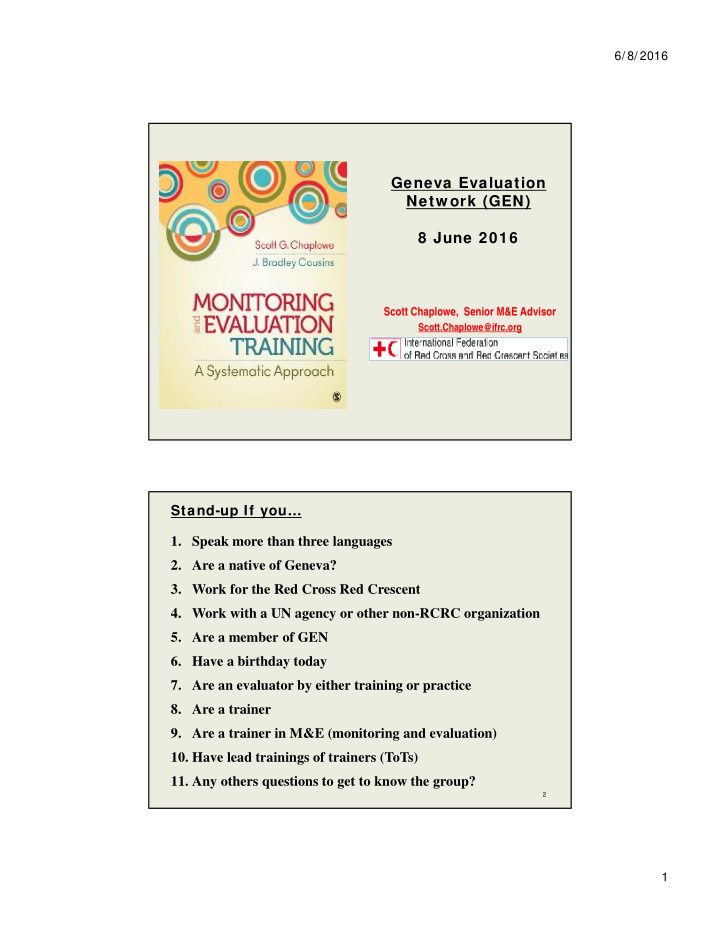



6/ 8/ 2016 Geneva Evaluation Network (GEN) 8 June 2016 Scott Chaplowe, Senior M&E Advisor Scott.Chaplowe@ifrc.org Stand-up If you… 1. Speak more than three languages 2. Are a native of Geneva? 3. Work for the Red Cross Red Crescent 4. Work with a UN agency or other non-RCRC organization 5. Are a member of GEN 6. Have a birthday today 7. Are an evaluator by either training or practice 8. Are a trainer 9. Are a trainer in M&E (monitoring and evaluation) 10. Have lead trainings of trainers (ToTs) 11. Any others questions to get to know the group? 2 1
6/ 8/ 2016 Today’s presentation w ill…. 1. Introduce our book 2. Introduce some key considerations for effective training, whether M&E or other topics 3. Introduce a few, practical activities that can be tailored for different training contexts 3 Problem 1 – M& E Resistance People’s resistance to M&E training is often heightened for the very reason they need it; they do not understand and value it. 4 2
6/ 8/ 2016 Problem 2 – Lack of Resources 5 Personal challenge… “Logical frameworks can straightjacket a project, imposing an outside, technocentric method that alienates rather than fosters local participation in project design and M&E.” Chaplowe, Scott G. and Engo-Tjéga, Ruth Bamela. 2007. “Civil Society Organizations and Evaluation: Lessons from Africa.” Evaluation. Vol 13(2): 257-274. 6 3
6/ 8/ 2016 Pilot a new type of M& E training… Premise: M&E training can be delivered in an enjoyable and meaningful way that engages leaners; such an approach helps demystify M&E so it can be better understood, owned and used. 7 Fun & Games w ith Logframes 8 4
6/ 8/ 2016 10 5
6/ 8/ 2016 Logical Bridge Game 11 M& E training can indeed be FUN! 12 6
6/ 8/ 2016 Writing a 439 page book (w ith over 400 cited resources) 13 Book Video https:/ / www.youtube.com/ watch?v=1emXtI4ki84 14 7
6/ 8/ 2016 Chapter 1 M& E Training that Makes a Difference � Plan, delivery and follow-up M&E training with attention to training transfer. � Meaningfully involve stakeholders in the M&E training process. 15 Training should be approached systematically and systemically 16 8
6/ 8/ 2016 Chapter 2 The Training Landscape Training does not happen in isolation; there are many other sources of learning. 17 18 9
6/ 8/ 2016 19 Chapter 3 The M& E Capacity Building Context Plan M&E training recognizing other factors and actors that can support or hinder training. 20 10
6/ 8/ 2016 Chapter 4 – Adult Learning “The existing literature provides some information concerning a practical application component; however, there is almost no discussion of pedagogy or, more specifically, the selection of teaching strategies for a program evaluation course.” (Oliver, Casiraghi, Henderson, Brooks, & Mulsow, 2008) “The fact that so many people have thought about, investigated, and written about the process of learning over the years suggests the complexity of the topic. Learning defies easy definition and simple theorizing.” (Merriam, Sharan & Baumgartner, 2007, p. 275) 21 Learning Energizer – Chocolate Estimates 1. Fold your paper into thirds 2. Privately write down chocolate estimate for number of chocolates in glass container (1 minute) 3. Turn to the person next to you and share your estimates (1 minute) 4. Privately revise your estimate if you want (5 seconds) 5. In small groups of ~5 people share your estimates and agree one count for the group – write it down on a piece of paper. (3 minutes) Chocolates will be awarded to the correct group ( with conditions ) 6. 22 11
6/ 8/ 2016 Kolb’s experiential learning cycle 23 Design and deliver M&E training that is grounded on the Principles of Adult Learning 1. Establish a safe and respectful 8. Make it active, fun, and challenging climate 9. Use mixed/multisensory methods 2. Respond to the “need to know” ff 10. Differentiate instruction (NTK) 11. Utilize collaborative, peer learning 3. Provide a structured yet flexible progression 12. Include practice and repetition 4. Empower with genuine 13. Design for primacy and recency participation 14. Provide feedback & and positive 5. Incorporate past experience reinforcement 6. Keep it relevant & meaningful 7. Provide direct experience 12
6/ 8/ 2016 Chapter 5 - What Makes a Good M& E Trainer? Uphold professional standards, principles and ethics for both training and M&E. 25 PART 2 A Systematic Approach to M& E Training “Give me six hours to chop down a tree and I will spend the first four sharpening the axe.” Abraham Lincoln Systematically approach M&E training, but remain flexible and adaptable to changing needs. 26 13
6/ 8/ 2016 27 14
6/ 8/ 2016 15
6/ 8/ 2016 16
6/ 8/ 2016 34 w w w.ScottChaplowe.com 17
6/ 8/ 2016 Key Message Review • People’s resistance to M&E training is often heightened for the very reason they need it; they do not understand and value it. • M&E training can be delivered in an enjoyable and meaningful way that engages leaners; such an approach helps demystify M&E so it can be better understood, appreciated and used. • Plan, delivery and follow-up M&E training with attention to training transfer. • Meaningfully involve stakeholders in the M&E training process, from design to delivery. • Training should be approached systematically and systemically. • Training does not happen in isolation; there are many other sources of learning. • Plan M&E training recognizing other factors and actors that can support or hinder training. • Design and deliver M&E training that is grounded on the Principles of Adult Learning. • Uphold professional standards, principles and ethics for both training and M&E. • Systematically approach M&E training, but remain flexible and adaptable to 35 changing needs. Indicators are like the dashboard of a car… 18
6/ 8/ 2016 Mixed Methods – Pocket Example Quantitative & Qualitative 37 19
Recommend
More recommend